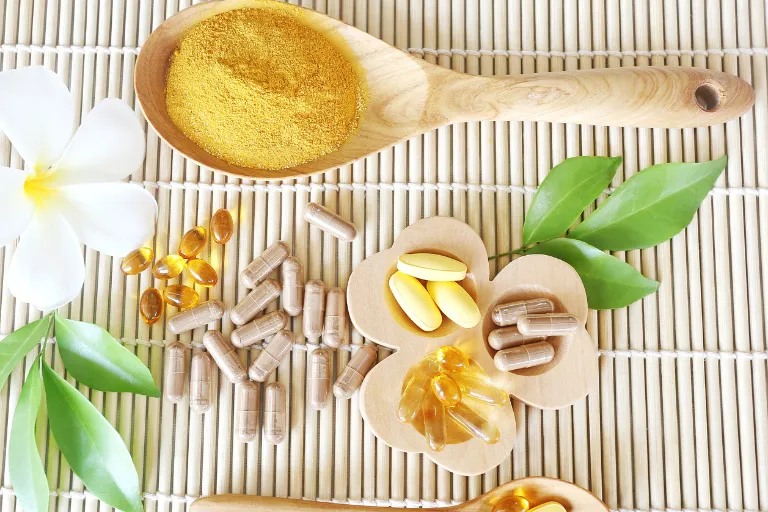Key Points
- Supplements like curcumin, omega-3 fatty acids, boswellia, and ginger remain among the most promising natural solutions for pain and inflammation.
- Newer compounds, including palmitoylethanolamide (PEA) and advanced CBD formulations, are gaining traction.
- Evidence shows supplements may help reduce reliance on conventional therapies, though safety, dosage, and interactions must be carefully considered.
- Combining supplements strategically (e.g., curcumin with piperine for absorption) may enhance effectiveness.
Why Finding Safer Pain Solutions Matters in 2025
Chronic joint pain and inflammation affect millions of Americans, limiting mobility, disrupting sleep, and diminishing overall quality of life. Conventional solutions such as NSAIDs may provide short-term relief, but they carry risks when used long-term, including digestive issues and cardiovascular concerns . In 2025, supplements once considered “alternative” are being recognised for their scientific credibility, giving people new tools that may help support comfort and joint function as part of a comprehensive approach, under professional guidance.
The Growing Impact of Inflammation on Daily Life
Pain and inflammation are not just fleeting discomforts—they represent underlying biological processes that can contribute to chronic symptoms affecting the heart, blood sugar regulation, and even brain function. Ignoring these signs can accelerate long-term health challenges.
At the same time, the global supplement market is expanding rapidly, projected to be worth USD 300 billion by 2028, with inflammation-support products leading the growth. The challenge for users is navigating between evidence-based options and products backed only by marketing.
Key Challenges in Managing Pain and Inflammation Naturally
- Serious adverse events of standard therapies in studies to date: Long-term NSAID use may increase risks of ulcers and heart problems.
- Individual variability: Genetic and lifestyle differences mean supplements may work differently for each person.
- Market confusion: With countless supplement choices—herbal extracts, omega oils, powders—knowing which ones are effective is overwhelming.
The Science Behind Anti-Inflammatory Supplements
Most pain-support supplements target the body’s inflammatory pathways by reducing the activity of pro-inflammatory enzymes and molecules.
- Curcumin (from turmeric) reduces levels of NF-κB, a protein complex involved in inflammation, but its natural absorption is poor without piperine.
- Omega-3 fatty acids (EPA and DHA) from fish and algae oil lower inflammatory prostaglandins, improving joint comfort and cardiovascular balance.
- Boswellia serrata inhibits the enzyme 5-lipoxygenase, linked to chronic joint swelling.
- Ginger contains compounds like gingerols that help reduce muscle soreness and joint stiffness.
- Palmitoylethanolamide (PEA), a newer lipid supplement, interacts with the endocannabinoid system to lower nerve-related pain.
- CBD (cannabidiol) continues to show promise in reducing inflammatory signalling, though research and regulation remain in flux.
The Best Supplements for Pain and Inflammation in 2025
1. Curcumin with Piperine for Enhanced Absorption
- Best for: Joint pain, inflammatory gut issues, and general inflammatory balance.
- Research: Studies confirm curcumin’s anti-inflammatory effects improve significantly when combined with black pepper extract.
2. Omega-3 Fatty Acids from Fish or Algal Oil
- Best for: Joint stiffness, cardiovascular health, and brain support.
- Research: Meta-analyses suggest 3.6 grams/day improves inflammatory markers and reduces pain scores.
3. Boswellia Serrata for Mobility Support
- Best for: Stiffness, swelling, and long-term joint mobility.
- Research: Standardised extracts with 40% boswellic acids have been shown to reduce knee pain and improve walking distance.
4. Ginger Extract for Natural Muscle and Joint Relief
- Best for: Muscle soreness, menstrual pain, and mild joint discomfort.
- Research: Studies suggest that daily ginger supplementation reduces delayed-onset muscle soreness and chronic stiffness.
5. Palmitoylethanolamide (PEA) as an Emerging Solution
- Best for: Nerve-related pain and widespread pain symptoms.
- Research: PEA has been well tolerated in studies and shows promise for neuropathic pain.
6. CBD Formulations for Inflammation Support
- Best for: Individuals seeking natural options where legal.
- Research: Studies highlight CBD’s potential to reduce inflammation, though dosage and regulation remain unsettled.
Stacking Strategies: Combining Supplements for Better Results
- Curcumin + Piperine + Omega-3: Enhances anti-inflammatory benefits across multiple pathways.
- Boswellia + PEA: May complement each other for both joint and nerve-related pain.
Stacking requires careful dosing and oversight by a health professional to minimise potential interactions.
Taking the Next Step Toward Safer Relief
Supplements can’t replace lifestyle strategies such as balanced nutrition, movement, and stress reduction—but they can provide meaningful support. Start with one option, track your response, and consult a licensed health professional before combining multiple products or if you’re taking medications.
Conclusion
The best supplements for pain and inflammation in 2025 reflect a balance between traditional remedies and new scientific discoveries. From turmeric’s golden compound to lipid-based molecules like PEA, today’s solutions are safer and more effective than ever. With a thoughtful approach, users can find natural allies to reduce discomfort, improve mobility, and restore more ease to daily life.
This blog post aims to be informational and should not replace professional health advice. Always consult with a health professional for personalised advice.
Subscribe for Free for more insightful health articles tailored to your needs.
Sources
- Coates PM, Bailey RL, Blumberg JB, El-Sohemy A, Floyd E, Goldenberg JZ, et al. The Evolution of Science and Regulation of Dietary Supplements: Past, Present, and Future. The Journal of Nutrition [Internet]. 2024 Jul 4;154(8). Available from: https://www.sciencedirect.com/science/article/pii/S0022316624003560
- Djaoudene O, Romano A, Bradai YD, Zebiri F, Ouchene A, Yousfi Y, et al. A Global Overview of Dietary Supplements: Regulation, Market Trends, Usage during the COVID-19 Pandemic, and Health Effects. Nutrients [Internet]. 2023 Jul 26;15(15):3320. Available from: https://pmc.ncbi.nlm.nih.gov/articles/PMC10421343/
- El-Saadony MT, Yang T, Korma SA, Sitohy M, Abd El-Mageed TA, Selim S, et al. Impacts of turmeric and its principal bioactive curcumin on human health: Pharmaceutical, medicinal, and food applications: A comprehensive review. Frontiers in Nutrition [Internet]. 2023 Jan 10;9. Available from: https://pmc.ncbi.nlm.nih.gov/articles/PMC9881416/
- Shawl M, Geetha T, Burnett D, Babu J. Omega-3 Supplementation and Its Effects on Osteoarthritis. Nutrients. 2024 May 28;16(11):1650–0.
- Ragab EA, Abd MF, Doghish AS, Salama RM, Eissa N, Darwish SF. The journey of boswellic acids from synthesis to pharmacological activities. Naunyn-Schmiedeberg’s archives of pharmacology [Internet]. 2023 Sep 23; Available from: https://www.ncbi.nlm.nih.gov/pmc/articles/PMC10858840/
- Gupta J, Sharma B, Sorout R, Singh RG, Ittishree N, Sharma MC. Ginger (Zingiber officinale) in Traditional Chinese Medicine: A Comprehensive Review of Its Anti-Inflammatory Properties and Clinical Applications. Pharmacological Research – Modern Chinese Medicine. 2024 Dec 1;100561–1.
- Alejo-Martínez A, Bravo G, López-Muñoz FJ. N-Palmitoylethanolamide enhances antinociceptive effect of tramadol in neuropathic rats. Biomedicine & Pharmacotherapy [Internet]. 2024 Dec 24;182:117760. Available from: https://www.sciencedirect.com/science/article/pii/S0753332224016469
- Tripson M, Litwa K, Soderstrom K. Cannabidiol inhibits neuroinflammatory responses and circuit-associated synaptic loss following damage to a songbird vocal pre-motor cortical-like region. Scientific Reports [Internet]. 2023 May 16 [cited 2023 Aug 2];13(1):7907. Available from: https://www.nature.com/articles/s41598-023-34924-z
- Preza-Rodríguez L, Camacho-Luis A, Simental-Mendía LE, Martínez-Aguilar G, Gamboa-Gomez CI, Guerrero-Romero F. Turmeric Plus Black Pepper for the Improvement and Remission of Metabolic Syndrome: A Randomized, Double-Blind, Placebo-Controlled Clinical Trial. Journal of Herbal Medicine. 2024 Jan 21;44:100845–5.
- Elisia I, Yeung M, Kowalski S, Wong J, Rafiei H, Dyer RA, et al. Omega 3 supplementation reduces C-reactive protein, prostaglandin E2 and the granulocyte/lymphocyte ratio in heavy smokers: An open-label randomized crossover trial. Frontiers in Nutrition [Internet]. 2022;9:1051418. Available from: https://pubmed.ncbi.nlm.nih.gov/36532545/
- Majeed A, Majeed S, Satish G, Manjunatha R, Rabbani SN, Patil NVP, et al. A standardized Boswellia serrata extract shows improvements in knee osteoarthritis within five days-a double-blind, randomized, three-arm, parallel-group, multi-center, placebo-controlled trial. Frontiers in Pharmacology [Internet]. 2024 Jul 18;15. Available from: https://pubmed.ncbi.nlm.nih.gov/39092235/
- Dominguez-Balmaseda D, Diez-Vega I, Larrosa M, San Juan AF, Issaly N, Moreno-Pérez D, et al. Effect of a Blend of Zingiber officinale Roscoe and Bixa orellana L. Herbal Supplement on the Recovery of Delayed-Onset Muscle Soreness Induced by Unaccustomed Eccentric Resistance Training: A Randomized, Triple-Blind, Placebo-Controlled Trial. Frontiers in Physiology [Internet]. 2020 Jul 21 [cited 2022 Apr 25];11:826. Available from: https://www.ncbi.nlm.nih.gov/pmc/articles/PMC7396658/
- Varrassi G, Rekatsina M, Giuseppe L, Cascella M, Finco G, Sardo S, et al. A Decades-Long Journey of Palmitoylethanolamide (PEA) for Chronic Neuropathic Pain Management: A Comprehensive Narrative Review. Pain and Therapy. 2024 Dec 4;
- Dubnika A, Jurgelane I, Grava-Ceplite A, Tornaci S, Porfiryeva NN, Solovyov D, et al. Exploring the therapeutic potential of cannabidiol in soft tissue wound healing: Delivery strategies and anti-inflammatory pathways. Acta Pharmaceutica Sinica B [Internet]. 2025 Oct 10; Available from: https://www.sciencedirect.com/science/article/pii/S2211383525006744





Natural allies to reduce discomfort’—beautifully said. I’m excited to start small and see what works for me.